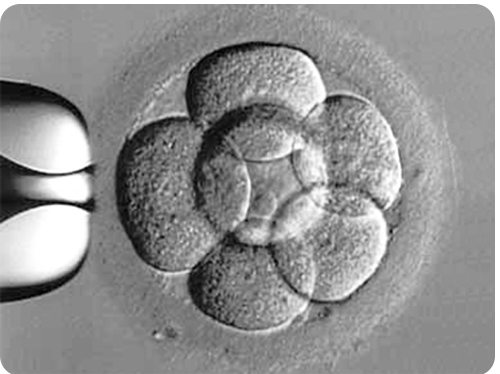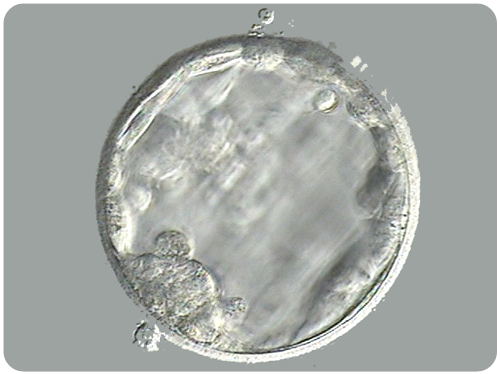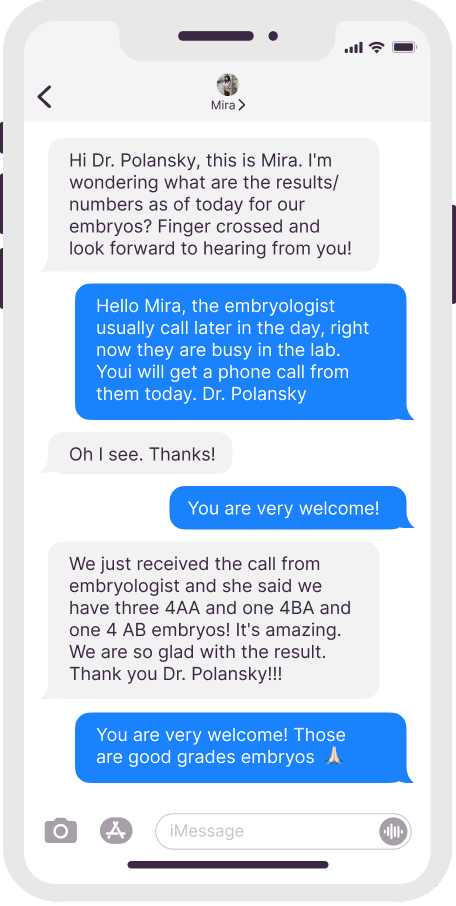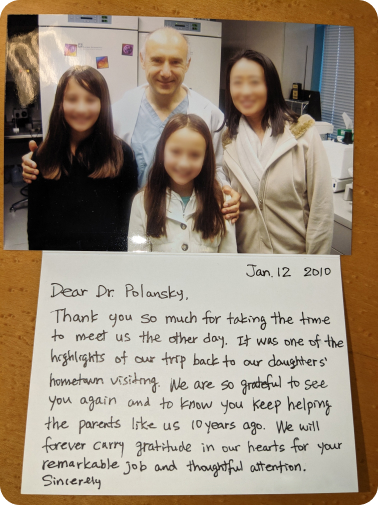


What Is Frozen Egg Donation
Frozen Egg Donation can be a highly successful treatment used for patients who no longer have high-quality eggs within their ovaries


Frozen Egg Donation” is an alternative to “fresh” (non-frozen) Egg Donation IVF treatment. Just like “fresh” Egg Donation, it can be a highly successful treatment for patients who no longer have sufficient quality eggs within their ovaries.
You choose your frozen donor eggs from a donor egg bank catalog. This is similar to choosing donor semen from a sperm bank.
Once you select the egg donor of your frozen eggs, the egg bank will ship your selected frozen eggs to our Clinic. The egg banks our embryologists recommend are Fairfax Egg Bank, Donor Egg Bank USA at California Cryobank, and Cryos International-USA.
Probability of Success: The likelihood of a successful pregnancy depends primarily on the fertility potential of the egg donor who provided your frozen donor eggs rather than your uterine receptivity or age.
The probability of a successful outcome with frozen donor eggs approaches the success of using “fresh” donor eggs.
Treatment Efficacy: We performed our first Egg Donation treatment in 1988. Since then, Donor Egg IVF has become a mainstream treatment for infertility. Over the years, we have streamlined and simplified the process of Donor Egg IVF to minimize interference with your egg donor’s lifestyle.
Frozen Donor Egg IVF Offspring: Children conceived with the help of Donor Egg IVF are genetically linked to the male partner and the egg donor, but the female partner is the one who becomes pregnant, nourishes the baby throughout the pregnancy, and experiences childbirth.
The baby receives one set of genes from the dad and another from an egg donor, but you, the mom carrying the pregnancy, make that baby your very own. The new science of epigenetics describes how our environment modifies gene expressions and possibly the genes themselves.
The epigenetic marks transmitted from the recipient mother are a fine-tuned mechanism to control gene activation during the complex process of early embryogenesis. And this maternal influence continues throughout the pregnancy. You will imprint yourself onto the baby! By the time your son or daughter is born, that baby will be biologically yours.
“Fresh” and Frozen Egg Donor IVF Comparison: In “fresh” Donor Egg IVF, the egg donor undergoes ovarian stimulation and egg retrieval. The eggs are inseminated with partner (or donor) sperm, and fertilized eggs are cultured in the laboratory. The resulting embryos are cryopreserved and subsequently transferred into the recipient mother’s uterus.
In Frozen Donor Egg IVF, the egg donor’s ovarian stimulation and egg retrieval have already taken place. The eggs have been vitrified (cryopreserved, frozen) by the egg bank. The cryopreserved eggs are shipped to Bay IVF, where they are thawed, inseminated, and the resulting embryos are frozen and subsequently transferred into the recipient mother’s uterus.
In both types of donor egg treatments, egg donors are tested for genetic and infectious diseases and are psychologically pre-screened.
Advantages of Frozen Donor Egg IVF: Frozen Donor Egg IVF may possibly be less costly than “fresh” Donor Egg IVF. The treatment length is shorter, and you may not need to decide what to do with extra embryos that might be left over after a successful “fresh” Donor Egg IVF treatment.
Advantages of “Fresh” Donor Egg IVF: “Fresh” Donor Egg IVF may have a higher success probability, and you may possibly have enough extra frozen embryos to improve your chances for a genetic sibling in the future.
Treatment Logistics: The rate of development of embryos from frozen donor eggs may be unpredictable, and it may not be possible to match the recipient’s uterine lining development with the development of the embryos.
This is resolved by thawing and inseminating the frozen donor eggs and freezing (vitrifying) the resulting embryos. The frozen embryos are thawed and transferred into the uterus in a subsequent Frozen Embryo Transfer.
Most embryos will survive the cryopreservation and thawing process. The implantation rate of the thawed embryos is equal to the “fresh” embryo implantation rate.
Obstetrical Care: Once your Frozen Embryo Transfer treatment at Bay IVF is completed (approximately 6-8 weeks into your pregnancy), your pregnancy will become indistinguishable from conception through intercourse, and your obstetrical care should be no different than if you conceived without any treatment.
Frozen Donor Egg IVF is a two-stage treatment. The first phase consists of the development and cryopreservation of embryos:
- Obtaining donor eggs from an egg bank
- Thawing of cryopreserved donor eggs
- Fertilization of eggs (Intracytoplasmic Sperm Injection – ICSI)
- Culture of embryos
- Cryopreservation of embryos
- Embryo storage
The second stage consists of the Frozen Embryo Transfer cycle.
Obtaining Donor Eggs from an Egg Bank: Once you have finalized the selection of your donor eggs, the egg bank will communicate with our Clinic, and our Embryology Laboratory will make preparations to receive your eggs. After their cryopreservation in the egg bank, eggs are stored and transported in liquid nitrogen containers. Once your eggs arrive at Bay IVF, they will be kept in liquid nitrogen storage until it is time to thaw them.
Thawing of Cryopreserved Donor Eggs: Since it is expected that not all cryopreserved eggs will survive the freezing-thawing process, and since not all thawed eggs will fertilize or develop into healthy embryos, you will be purchasing a cohort of eggs. You should expect to receive between 5 and 8 vitrified eggs from the egg bank.
Such a cohort will likely produce some good-quality embryos suitable for transfer.
Fertilization of Eggs: The male partner collects a semen specimen by masturbation on the day of thawing the eggs. The highest quality sperm are extracted from the semen, and Intracytoplasmic Sperm Injection (ICSI) is performed. In ICSI, a single sperm is inserted into an egg. ICSI is necessary for the fertilization of cryopreserved eggs.
Culture of Embryos: Evidence of fertilization can be seen the next day, 16 hours after ICSI. The fertilized eggs are transferred into a growth medium and continue to be cultured in our laboratory.
A normally fertilized egg (zygote) will show two pronuclei representing the genetic material from the egg and sperm.
The following day, embryos should divide into 4 cells, and the day after that, into 8 cells.
This picture shows a morphologically exquisite, day three, 8-cell embryo. Human embryos are still microscopic and invisible to the naked eye at this stage.

By the fifth to seventh day after the insemination, embryos should reach the blastocyst stage (80 or more cells).
This picture shows an advanced stage of blastocyst development. Notice the central fluid-filled cavity. The cells within the blastocyst have already differentiated into the inner cell mass (at seven o’clock) that will give rise to the fetus and the trophectoderm cells that will form the future placenta.

Cryopreservation of Embryos: Embryos that develop normally are cryopreserved. Preparation for the freezing process involves removing water from within the embryos and replacing it with a cryoprotective substance to prevent ice crystal formation during vitrification and subsequent thawing. The embryos are then flash-cooled to -196°C (-321°F). Such rapid freezing (vitrification) prevents damaging water crystal formation.
Embryo Storage: Following the vitrification process, the embryos are transferred into a liquid nitrogen storage chamber in our Clinic. Theoretically, there is no limit on the length of storage, but conceiving past the age of 40 may result in a high-risk pregnancy.
Once you decide to conceive with your cryopreserved embryos, you will have one or two embryos thawed and transferred into your uterus. A large majority of the embryos will survive the vitrification and thawing process. The implantation rate of the thawed embryos should be the same.

We look forward to meeting you at Bay IVF and, when your treatment is successful, celebrating your new pregnancy!
 +
+Years of Experience
 +
+Babies Born
 %
%Compassionate Care


Hear from Our Patients’ Journey to Parenthood at Bay IVF!

I would highly recommend Bay IVF for those wanting to build their family and needing IVF support! Dr. Polansky and the whole Bay IVF team were so supportive and welcoming while also honest and realistic. Our girl is our dream come true!
Jennifer C.-F.This clinic has been amazing to work with. All the nurses and staff made sure I was always comfortable and were there to answer questions any time I needed. We are incredibly grateful to Dr. Polansky and the team for everything they did for us.
Harpreet K.Words could never express the gratitude my husband and I will always have for Bay IVF! We did our research and decided to check out Bay IVF. We scheduled a consultation and felt an instant connection… love at first sight!
Chelsea L.
Bay IVF Early Pregnancy Heartbeat

Meet Your Doctor

- Dr. Polansky received his medical diploma from Charles University in Prague, the Czech Republic, in 1978.
- After completing his OB/GYN residency at Jewish Hospital in Saint Louis, MO, he graduated from the Reproductive Endocrinology and Infertility (REI) fellowship at Stanford University in 1985.
- In the same year, he co-founded the Stanford IVF Clinic.
- Dr. Polansky obtained board certification in Obstetrics and Gynecology in 1986 and became REI subspecialty board certified in 1988.
- In 1987, he left Stanford University and established Nova IVF.
- In 2011, he founded Bay IVF, where he provides advanced fertility treatments with a holistic approach, utilizing state-of-the-art techniques.
- Dr. Polansky personally performs ultrasound examinations, egg retrievals, embryo transfers, and ovarian and endometrial stimulations for his patients.
- He is deeply committed to his patients and freely shares his cell phone number, ensuring accessibility and availability 24/7.
Frank Polansky, M.D.

Dr. Polansky’s Communication With Patients
Real texts, anonymous patient names












Initial Appointment Questions
When you call to schedule your consultation, Erica will ask you a short series of questions regarding your reproductive history.
Patients’ Thank You Cards


















Your Initial Visit at Bay IVF
Attending a new patient appointment at a fertility clinic can be stressful. Our primary objective is to ensure that your initial visit is friendly and relaxing. We encourage you to ask questions at every step of the process.

1 — When You Arrive
You will be welcomed by one of the clinic receptionists. One of our nurses will measure your height and weight and take your blood pressure

2 — Meet Your Doctor
Dr. Polansky will ask you a series of clarifying questions and then provide you with a summary of the factors contributing to your infertility

4 — Exam Room
One of the nurses will escort you to an examination room. Your examination will begin with listening to your lungs and heart

3 — Ask Your Questions
You will then have a discussion with him about the most suitable reproductive treatment(s) for you. During this time, you will have the opportunity to ask any questions you may have

5 — Ultrasound of the Ovaries
The next step is a pelvic ultrasound to examine the uterus and ovaries. This ultrasound will help determine the number of antral follicles present within the ovaries

6 — Financial Part
Following that, you will have a discussion with one of the financial advisors regarding the financial aspects of your treatment, including potential treatment financing options

8 — Support 24/7
If you have any questions after leaving the clinic, please feel free to reach out to us via phone call, text, or email. Open and discreet communication is an integral part of the care we provide at Bay IVF

7 — What About Time?
Your entire visit is expected to last approximately one hour


Schedule Your Initial Consultation With Dr. Polansky
Online or In-Person
You can also complete the form below to request your initial consultation


Still Have Questions?
We know this is a big decision. It is important for us that you feel really comfortable.








